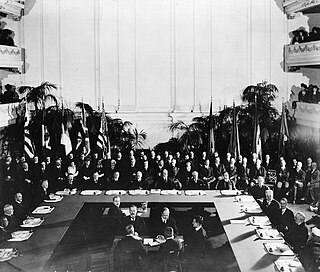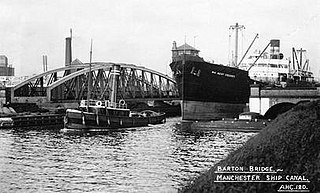
The Washington Naval Treaty, also known as the Five-Power Treaty, was a treaty signed during 1922 among the major Allies of World War I, which agreed to prevent an arms race by limiting naval construction. It was negotiated at the Washington Naval Conference in Washington, D.C. from November 1921 to February 1922 and signed by the governments of the United Kingdom, United States, France, Italy, and Japan. It limited the construction of battleships, battlecruisers and aircraft carriers by the signatories. The numbers of other categories of warships, including cruisers, destroyers, and submarines, were not limited by the treaty, but those ships were limited to 10,000 tons displacement each.

The United States Asiatic Fleet was a fleet of the United States Navy during much of the first half of the 20th century. Before World War II, the fleet patrolled the Philippine Islands. Much of the fleet was destroyed by the Japanese by February 1942, after which it was dissolved, and the remnants incorporated into the naval component of the South West Pacific Area command, which eventually became the Seventh Fleet.

The Soviet Navy was the naval warfare uniform service branch of the Soviet Armed Forces. Often referred to as the Red Fleet, the Soviet Navy made up a large part of the Soviet Union's strategic planning in the event of a conflict with the opposing superpower, the United States, during the Cold War (1945–1991). The Soviet Navy played a large role during the Cold War, either confronting the North Atlantic Treaty Organization in western Europe or power projection to maintain its sphere of influence in eastern Europe.
USS Napa (AT-32), originally Yucca, was a Bagaduce-class fleet tug of the United States Navy. The ship was laid down as Napa on 5 March 1919, at the Puget Sound Naval Shipyard, Washington; launched on 24 July 1919; and commissioned on 5 December 1919.
USS Cotinga (AMc-43), a U.S. Navy Accentor-class coastal minesweeper built for the U.S. Navy for service in World War II, was named after the cotinga, a passerine bird of South America and Central America.
USS Adamant (AMc-62) was an Accentor-class minesweeper in the United States Navy during World War II.

USS Wassuc (CMc-3), originally a steel-hulled, coastal passenger vessel built in 1924 at Elizabethport, New Jersey, by the New Jersey Drydock and Transportation Corp. of New York City as SS Yale, was acquired by the U.S. Navy on 20 December 1940. SS Yale then began conversion to a coastal minelayer at the New York Navy Yard. Classified CMc-3 on 30 December 1940 and renamed USS Wassuc on 10 January 1941, the ship was commissioned at the New York Navy Yard on 15 May 1941.
USS Limpkin (AMc-48) was an Accentor-class coastal minesweeper acquired by the United States Navy for clearing coastal minefields. The vessel was launched on 5 April 1941 and entered service on 8 August. Limpkin operated off New York City and the mouth of Chesapeake Bay during World War II. Following the war, the minesweeper was taken out of service on 15 April 1946 and sold to private interests and converted to a commercial trawler. The ship was renamed Hiawatha and then Blue Waters.
USS Security (AMc-103) was an Accentor-class coastal minesweeper acquired by the U.S. Navy for the dangerous task of removing mines from minefields laid in the water to prevent ships from passing.
USS Radiant (AMc-99) was an Accentor-class coastal minesweeper acquired by the U.S. Navy for the dangerous task of removing mines from minefields laid in the water to prevent ships from passing.
USS Detector (AMc-75) was an Accentor-class coastal minesweeper acquired by the U.S. Navy for the dangerous task of removing mines from minefields laid in the water to prevent ships from passing.
USS Dominant (AMc-76) was an Accentor-class coastal minesweeper acquired by the U.S. Navy for the dangerous task of removing mines from minefields laid in the water to prevent ships from passing.
USS Advance (AMc-63) was an Accentor-class coastal minesweeper acquired by the United States Navy for the task of removing mines from minefields laid in the water to prevent ships from passing.

USS Aggressor (AMc-64) was an Accentor-class coastal minesweeper acquired by the U.S. Navy for the dangerous task of removing mines from minefields laid in the water to prevent ships from passing.
USS Assertive (AMc-65) was an Accentor-class coastal minesweeper acquired by the U.S. Navy for the dangerous task of removing mines from minefields laid in the water to prevent ships from passing.

Chachalaca (AMc-41) was an Accentor-class coastal minesweeper built by the Bristol Yacht Building Company, South Bristol, Maine and delivered to the U.S. Navy at the Boston Navy Yard in August 1941.
USS Ostrich (AMc-51) was an Accentor-class coastal minesweeper acquired by the U.S. Navy.

USS Brambling (AMS-42/YMS-109) was a YMS-1-class auxiliary motor minesweeper acquired by the U.S. Navy for the task of removing mines from water that had been placed there to prevent ships from passing.

The Royal Navy, commonly the Royal Yugoslav Navy, was the naval warfare service branch of the Kingdom of Yugoslavia. It was brought into existence in 1921, and initially consisted of a few former Austro-Hungarian Navy vessels surrendered at the conclusion of World War I and transferred to the new nation state under the terms of the Treaty of Saint-Germain-en-Laye. The only modern sea-going warships transferred to the new state were twelve steam-powered torpedo boats, although it did receive four capable river monitors for use on the Danube and other large rivers. Significant new acquisitions began in 1926 with a former German light cruiser, followed by the commissioning of two motor torpedo boats (MTBs) and a small submarine flotilla over the next few years. When the name of the state was changed to Yugoslavia in 1929, the name of its navy was changed to reflect this. In the late 1920s, several of the original vessels were discarded.

SS West Cressey was a steel-hulled cargo ship that saw a brief period of service as an auxiliary with the U.S. Navy in the aftermath of World War I.








